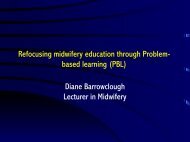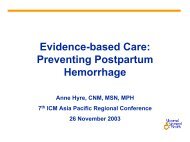Influencing Student Learning through a Portfolio of Clinical Evidence
Influencing Student Learning through a Portfolio of Clinical Evidence
Influencing Student Learning through a Portfolio of Clinical Evidence
Create successful ePaper yourself
Turn your PDF publications into a flip-book with our unique Google optimized e-Paper software.
Ci Ci StuartDepartment <strong>of</strong> Midwifery & Children’s NursingThe University <strong>of</strong> Sheffield<strong>Influencing</strong> <strong>Student</strong><strong>Learning</strong> <strong>through</strong>a <strong>Portfolio</strong> <strong>of</strong><strong>Clinical</strong> <strong>Evidence</strong>
<strong>Influencing</strong> <strong>Student</strong> <strong>Learning</strong> <strong>through</strong> a<strong>Portfolio</strong> <strong>of</strong> <strong>Clinical</strong> <strong>Evidence</strong>IntroductionUKCC 1999 - Fitness for practice:• Assessment strategies tend to be reductionist• <strong>Student</strong>s unable to transfer learning• <strong>Student</strong>s unable to provide holistic careUKCC (1999) Fitness for practice. London, UKCC.
<strong>Influencing</strong> <strong>Student</strong> <strong>Learning</strong> <strong>through</strong> a<strong>Portfolio</strong> <strong>of</strong> <strong>Clinical</strong> <strong>Evidence</strong>Problem-based learning curriculum: key aims• Integrate theory with practice• Give woman-centred care to give holistic care needsIn the classroom:• <strong>Learning</strong> situations/triggersDuring clinical practice:• <strong>Portfolio</strong> <strong>of</strong> clinical evidence
<strong>Influencing</strong> <strong>Student</strong> <strong>Learning</strong> <strong>through</strong> a<strong>Portfolio</strong> <strong>of</strong> <strong>Clinical</strong> <strong>Evidence</strong><strong>Portfolio</strong> <strong>of</strong> clinical evidence: key elements1. Achievement <strong>of</strong> statutory midwifery competencies2. Development <strong>of</strong> a set <strong>of</strong> prescribed pr<strong>of</strong>essional behaviours3. ‘Supplementary evidence’4. Record <strong>of</strong> statutory clinical midwifery experience5. <strong>Clinical</strong> skills inventoryThe above elements form the Assessment Tool for theassessment <strong>of</strong> clinical practice
<strong>Influencing</strong> <strong>Student</strong> <strong>Learning</strong> <strong>through</strong> a<strong>Portfolio</strong> <strong>of</strong> <strong>Clinical</strong> <strong>Evidence</strong>Statutory Midwifery Competencies• Assessed as PASS or FAIL only by the clinical mentor• At 3 levels <strong>of</strong> performance• Each level has an associated set* <strong>of</strong> the:Level <strong>of</strong> supervision/supportLevel <strong>of</strong> practiceConditions <strong>of</strong> practice for the achievement <strong>of</strong> clinical competencies* Stuart CC (2003) Assessment, Supervision and Support in <strong>Clinical</strong> Practice.Edinburgh, Churchill Livingstone.
<strong>Influencing</strong> <strong>Student</strong> <strong>Learning</strong> <strong>through</strong> a<strong>Portfolio</strong> <strong>of</strong> <strong>Clinical</strong> <strong>Evidence</strong>Pr<strong>of</strong>essional BehavioursAim:Facilitate the development <strong>of</strong> those behaviours expected <strong>of</strong> a pr<strong>of</strong>essionalmidwifeAssumption:Attitudes and values underpin our behaviours - indirect assessment <strong>of</strong> theseHow?‘Pr<strong>of</strong>essional behaviours inventory’ comprising 12 key ‘behaviours’Each behaviour consist <strong>of</strong> highly specified descriptors that are observableAssessed formatively and summatively by the clinical mentor
<strong>Influencing</strong> <strong>Student</strong> <strong>Learning</strong> <strong>through</strong> a<strong>Portfolio</strong> <strong>of</strong> <strong>Clinical</strong> <strong>Evidence</strong>Supplementary <strong>Evidence</strong>Aims:• Relate theory with practice• Develop a critical awareness <strong>of</strong> care• Demonstrate evidence-based practice• Develop into reflective practitionersHow?Written learning accounts that stem from clinical experience
<strong>Influencing</strong> <strong>Student</strong> <strong>Learning</strong> <strong>through</strong> a<strong>Portfolio</strong> <strong>of</strong> <strong>Clinical</strong> <strong>Evidence</strong>Supplementary <strong>Evidence</strong> – continued …Types <strong>of</strong> written learning accounts1. Reflective account <strong>of</strong> care2. Research critique/review <strong>of</strong> research that relate directly to care3. <strong>Learning</strong> accounts <strong>of</strong> clinical activities other than direct client care4. Reflection on other resources such as literature given to women,policies and protocolsAssessed summatively by the midwifery lecturer
<strong>Influencing</strong> <strong>Student</strong> <strong>Learning</strong> <strong>through</strong> a<strong>Portfolio</strong> <strong>of</strong> <strong>Clinical</strong> <strong>Evidence</strong>‣ How we assess (<strong>through</strong> the tasks in which students engage) affectswhat and how students learn (Gipps 1994)‣ The aim <strong>of</strong> assessment should be to facilitate learning (Stuart 2003)• Develop a critical awareness <strong>of</strong> care• Develop into reflective practitioners• Acquire those midwifery skills to give woman-centred careThe result <strong>of</strong> the use <strong>of</strong> this assessment tool – the portfolio <strong>of</strong> clinicalevidence - has indeed facilitated learning and these outcomes arebeing achieved.Gipps CV (1994) Beyond Testing: Towards a Theory <strong>of</strong> Educational Assessment. London, The Falmer Press.Stuart CC (2003) Assessment, Supervision and Support in <strong>Clinical</strong> Practice. Edinburgh, Churchill Livingstone.
<strong>Influencing</strong> <strong>Student</strong> <strong>Learning</strong> <strong>through</strong>a <strong>Portfolio</strong> <strong>of</strong> <strong>Clinical</strong> <strong>Evidence</strong>‣Questioning routine practices.. the study <strong>of</strong> these guidelines has caused me to really look into third stagemanagement … if a woman has had a normal, natural delivery, why then can she nothave a natural third stage? It has also caused me to question midwives’ motives as towhy they insist on women having an actively managed third stage – is it for the woman ordo they want a quick delivery? (student 1)In the unit where I work an abdominal examination is rarely performed during labour,except for the initial examination on admission, whilst it is common for women to beexamined per vaginam every two hours … our care <strong>of</strong> labouring women could beimproved by performing more abdominal examinations and less vaginal ones (student 2)
<strong>Influencing</strong> <strong>Student</strong> <strong>Learning</strong> <strong>through</strong>a <strong>Portfolio</strong> <strong>of</strong> <strong>Clinical</strong> <strong>Evidence</strong>‣Using research evidence to support recommendations to changepracticeThe dorsal position which women so <strong>of</strong>ten prefer is actually the worse position for thethird stage and therefore should be discouraged … particularly if the woman wants aphysiological third stage. If women prefer the dorsal position then active managementshould automatically be encouraged to prevent complications arising … position is veryimportant because gravity aids descent and expulsion <strong>of</strong> the placenta. The mosteffective positions are upright positions such as squatting and all fours … (student 3)
<strong>Influencing</strong> <strong>Student</strong> <strong>Learning</strong> <strong>through</strong>a <strong>Portfolio</strong> <strong>of</strong> <strong>Clinical</strong> <strong>Evidence</strong>‣ Increasing awareness <strong>of</strong> personal practices‣ Developing communication skills… like the midwives in Olsen’s (1999) study, I tend not to give much thought to consentfor the [abdominal] examination and as a result may ask for permission to perform theexamination in a way which does not convey to the woman that she has a choice. Isometimes use phrases such as ‘good size’ and ‘growing well’ to describe the fetuswhich, without explanation may lead the woman to worry that the baby will be too big forher to deliver (Stapleton et al. 2002). As a result I feel that I need to give moreconsideration to the language I use when talking to a woman before and during anabdominal examination … (student 2)this experience [<strong>of</strong> having reflected on how parents were told that they had a baby withDown’s syndrome] has helped me see that it is important to work on and develop myinterpersonal skills as well as my clinical skills (student 5)
<strong>Influencing</strong> <strong>Student</strong> <strong>Learning</strong> <strong>through</strong>a <strong>Portfolio</strong> <strong>of</strong> <strong>Clinical</strong> <strong>Evidence</strong>‣ Increased awareness <strong>of</strong> personal practices‣ Developing communication skills … continued …this piece <strong>of</strong> work [reflective account <strong>of</strong> care] has made me think about ‘choice’ and‘consent’. It has made me realise that sometimes women are not given informed choice.Poor communication skills and closed questions <strong>of</strong>ten lead women giving consent forsomething they don’t truly understand or want … Communication with the woman andher partner is vital in building a relationship, which is based on trust (student 6)
<strong>Influencing</strong> <strong>Student</strong> <strong>Learning</strong> <strong>through</strong>a <strong>Portfolio</strong> <strong>of</strong> <strong>Clinical</strong> <strong>Evidence</strong>‣ Increasing confidence in empowering women to makeinformed choicesI now feel more confident that I am able to explain to parents why we administer vitaminK and feel that I am more equipped to enable them to make informed choices abouthow vitamin K is administered … (student 4)[with] the information I have gained from studying these guidelines and researchingaround the issues [<strong>of</strong> the management <strong>of</strong> the third stage <strong>of</strong> labour], I really want to pushfor women to be more informed about how they wish their third stage to be managed(student 1)
<strong>Influencing</strong> <strong>Student</strong> <strong>Learning</strong> <strong>through</strong>a <strong>Portfolio</strong> <strong>of</strong> <strong>Clinical</strong> <strong>Evidence</strong>‣ Increased sensitivity to the woman and baby as persons… it is important in practice to remember that behind every procedure there is a humanbeing (student 6)Unfortunately the infliction <strong>of</strong> pain is seen as a necessary aspect <strong>of</strong> performing theGuthrie test. Undertaking [it] is an important part <strong>of</strong> the midwife’s role … it is essentialthat a midwife appreciates the distress it can cause to both parents and baby(student 9)
<strong>Influencing</strong> <strong>Student</strong> <strong>Learning</strong> <strong>through</strong>a <strong>Portfolio</strong> <strong>of</strong> <strong>Clinical</strong> <strong>Evidence</strong>‣ Triggers self-directed learningWhat I have seen and the things I have read have encouraged me to seek to developmy practice to be able to provide better care for the women I may encounter in similarcircumstances [student 7: after reflecting on a leaflet given to women after a miscarriage]Through my extensive reading about breastfeeding I have come to realise just what acomplex subject it is and that I did have gaps in my knowledge (student 8)
<strong>Influencing</strong> <strong>Student</strong> <strong>Learning</strong> <strong>through</strong>a <strong>Portfolio</strong> <strong>of</strong> <strong>Clinical</strong> <strong>Evidence</strong>CONCLUSIONChallenging and hard work for both students and lecturersWorthwhile introducing this assessment toolHow we are assessing are definitely influencing what and how the students arelearning so that they can become those midwives who are more likely to be able togive woman-centred care




